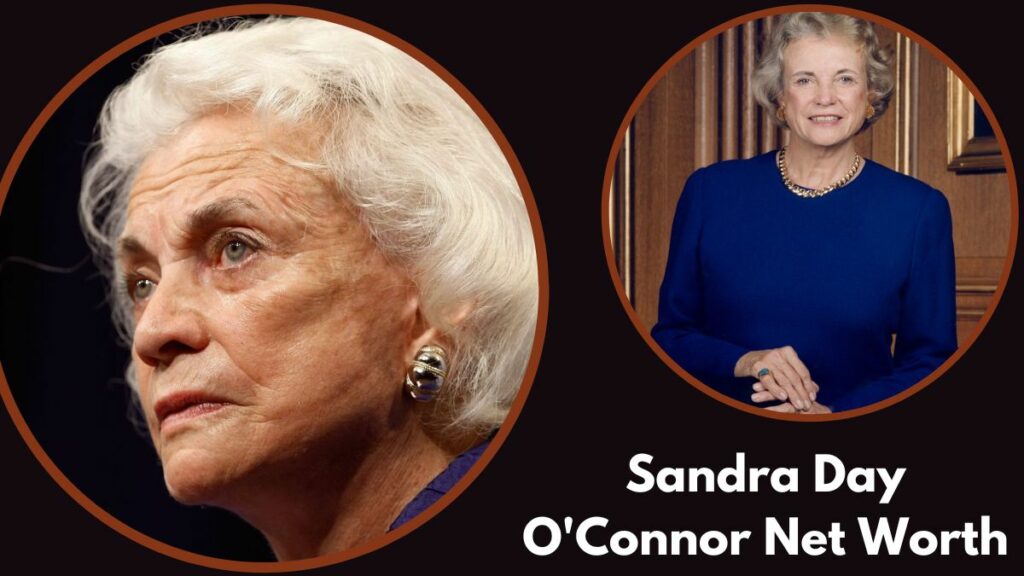Ada Mae and rancher Harry welcomed Sandra Day O’Connor into the world on March 26, 1930, in El Paso, Texas. She grew up hunting coyotes and jackrabbits on a 198,000-acre cattle ranch outside Duncan, Arizona.
O’Connor had a younger brother, Alan, and a younger sister, Ann, who was a member of the Arizona Legislature. She attended the Radford School for Girls while living in El Paso with her grandmother for her early education. In 1946, she graduated from Austin High School.
After that, O’Connor went to Stanford University, where she earned a bachelor’s degree in economics with honours in 1950, graduating magna cum laude. In 1952, she graduated from Stanford Law School with a law degree.
Sandra Day O’Connor Net Worth
At the time of her passing, Sandra Day O’Connor, an American lawyer, Supreme Court justice, and politician, was worth $8 million. The US Supreme Court appointed Sandra Day O’Connor as its first female associate justice from 1981 until 2006.

She was the Republican leader of the Arizona Senate and a judge before this. Frequently aligning with the conservative faction of the Court, O’Connor authored majority rulings in significant cases including Grutter v. Bollinger and Hamdi v. Rumsfeld.
In 2004 Sandra’s net worth fluctuated from $3 million to $6.5 million, based on the last financial statement she made while serving as a justice on the Supreme Court.
Sandra Day O’Connor Career Beginnings
O’Connor married and started working as a deputy county attorney in San Mateo, California, following his graduation from law school. Following her husband’s enlistment in the Army’s Quartermaster Corps, she moved to Germany to work as a civilian lawyer.
They stayed there for three years before coming back to the United States and relocating to Maricopa County, Arizona. There, O’Connor assisted in Arizona Senator Barry Goldwater’s presidential campaign and volunteered for other political organizations.
She was Arizona’s associate attorney general from 1965 to 1969. She was then appointed to the state Senate to cover a vacancy. In 1972, O’Connor emerged victorious in the race for that seat, making history as the first female majority leader of a state in the Senate.
Her term on the Maricopa County Superior Court ran from 1975 to 1979 after her appointment in 1974. Next, O’Connor received a promotion to the State Court of Appeals for Arizona.
Sandra Day O’Connor US Supreme Court
Ronald Reagan pledged during his 1980 presidential campaign that he would name the nation’s first female Supreme Court justice. He made good on his promise by nominating O’Connor in the summer of 1981.
With a vote of 99 to 0, O’Connor received the most votes ever for a US Supreme Court confirmation in September from the Senate. She primarily sided with Antonin Scalia, Anthony Kennedy, and William Rehnquist on the Court, although she frequently acted as the swing vote as well.
In significant cases including Grutter v. Bollinger, Lockyer v. Andrade, United States v. Lopez, and, most notably, Bush v. Gore—in which she helped to derail Gore’s presidential aspirations—O’Connor was a member of the majority.
O’Connor was erratic in a number of her court rulings regarding First Amendment Establishment Clause disputes. Her observance of the Fourth Amendment was more constant.
In her support of a woman’s freedom to choose, O’Connor frequently departed from the prevailing conservative philosophy when it came to abortion. Generally speaking, O’Connor was well-known on the Court for her case-by-case analysis of cases, which some thought was rational but others said lacked a cogent judicial philosophy.
Here, you can also look up the other celebrities’ net worth on our website:
- Nick Cannon Net Worth: What He Pays for 12 Kids’ Child Support?
- Victor Braga Net Worth: The Life and Career of Legend
Sandra Day O’Connor Retirement and a Later Career
In the summer of 2005, O’Connor declared her resignation from the Supreme Court. But later in the year, Justice Rehnquist passed away, leaving a fresh vacancy on the Court, which compounded matters.
O’Connor responded by remaining on the Court until it was confirmed who would replace her. Samual Alito eventually succeeded her at the beginning of 2006. O’Connor kept hearing cases in federal district courts and courts of appeals after she retired.
She also gave speeches at several other locations, such as the William & Mary School of Law, Elon University School of Law, and Georgetown University. She started instructing a yearly two-week course at the James E. Rogers College of Law at the University of Arizona in the spring of 2006.
In addition, O’Connor wrote the 2013 book “Out of Order: Stories from the History of the Supreme Court” and published many essays in journals like the Financial Times and the Denver University Law Review. See the tweet for more details:
Today, a legend, Sandra Day O’Connor, the first woman on the Supreme Court, passed. I had the honor of working with her on Alzheimer’s, where she was a forceful advocate. She broke so many barriers. She was smart, strong, determined, a ceiling breaker, a break down the door type… pic.twitter.com/F7cUdP3lli
— Maria Shriver (@mariashriver) December 1, 2023
Sandra Day O’Connor Personal Life and Philanthropy
O’Connor wed John Jay O’Connor III in 1952. They got to know one another while attending Stanford Law School. The pair was involved in the social scene of Washington, DC when O’Connor was a member of the Court.
Her spouse suffered from Alzheimer’s for nearly two decades. 2009 saw his passing. O’Connor has since pushed to increase public knowledge of the disease. She received a dementia diagnosis herself in 2018.
O’Connor established the non-profit Sandra Day O’Connor Institute in 2009 intending to promote civic engagement and education. She also introduced Our Courts, a website with interactive civics courses for educators and students, in that same year.
The website quickly changed to become iCivics, which provides a variety of free lesson plans and instructional games.
In addition to her several charitable pursuits, O’Connor served as the initial co-chair of the National Advisory Board at the National Institute for Civil Discourse, established at the University of Arizona in the wake of Gabby Giffords’ shooting in 2011. At the age of 93, Sandra Day O’Connor passed away on December 1, 2023.
We hope that the details we’ve offered will fulfil your needs. The information we’ve provided should be adequate. If you found this post helpful, kindly provide feedback in the section below.




